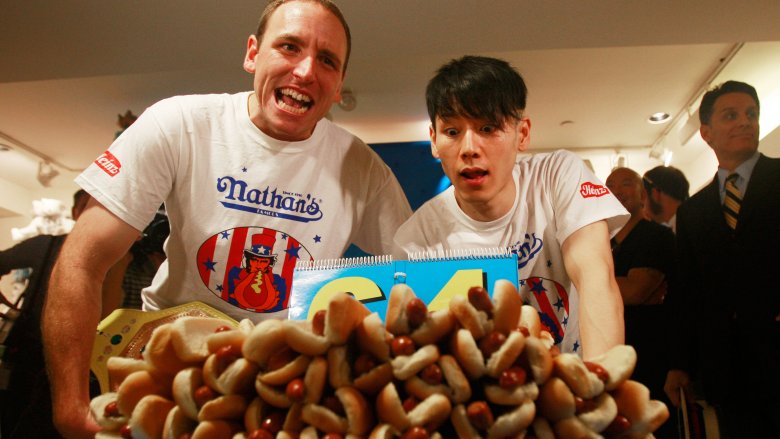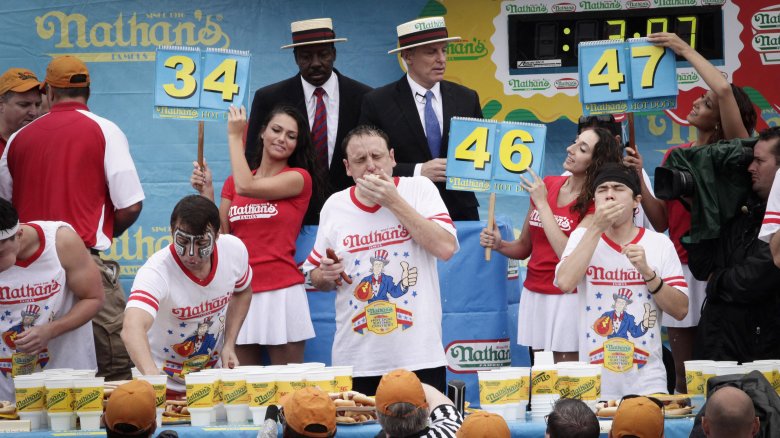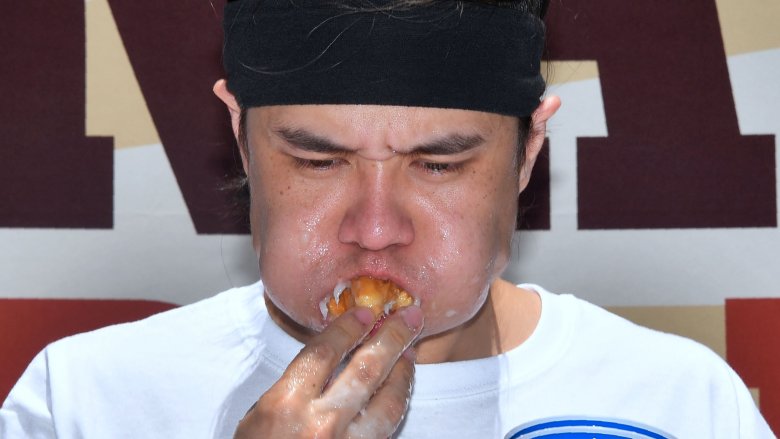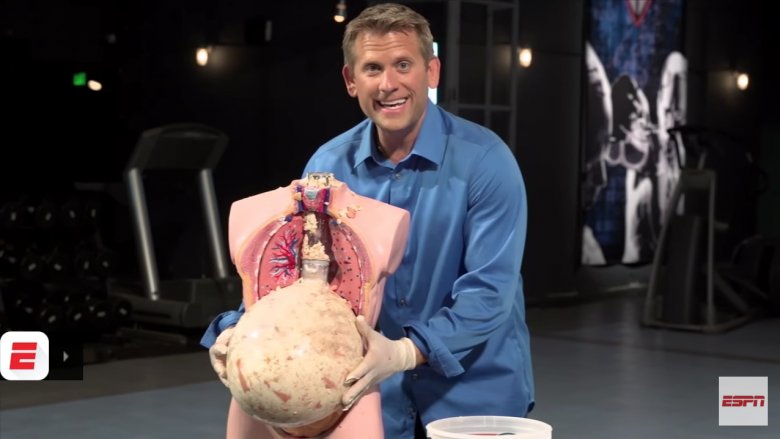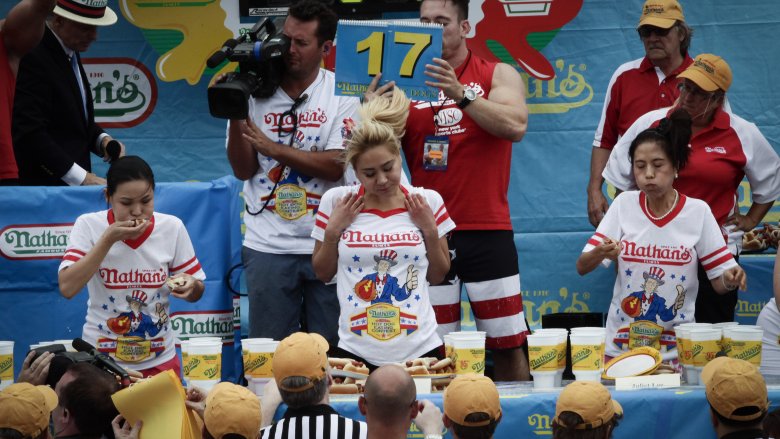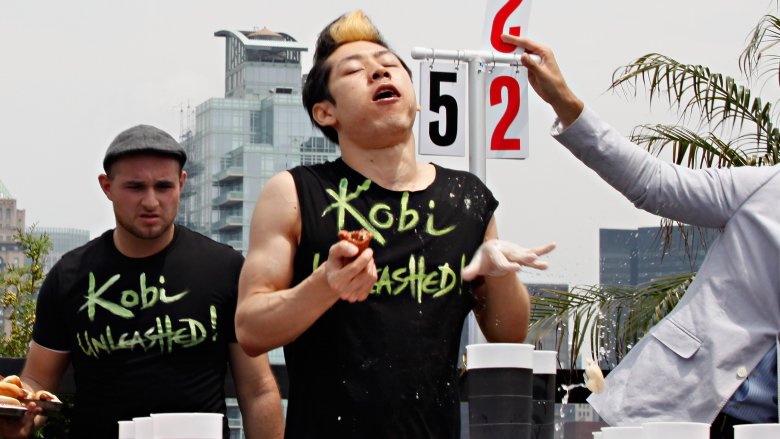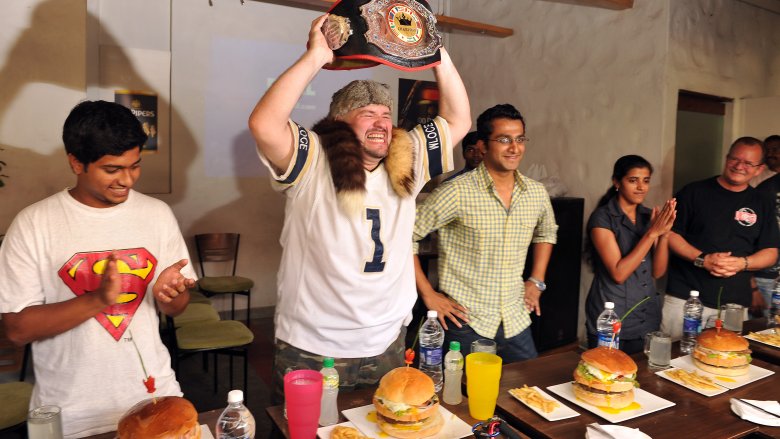The Untold Truth Of Competitive Eating
We may receive a commission on purchases made from links.
On the surface, competitive eating sounds like a dream gig. All you have to do is eat as much as you possibly can, as fast as you possibly can, with the chance of winning thousands of dollars. Sounds pretty great, right? Not so fast...
We've got bad news for all you speed-eating hopefuls out there: Unless you really love hot dogs and glazed doughnuts and hard-boiled eggs — and we mean really love them — the dark side of eating competitions will probably be enough to dissuade you from making a career change. Turns out it's not easy being Joey Chestnut, reigning world champ of Major League Eating.
From the rigorous pre-competition training to the very real possibility of choking to death, wolfing down dozens of hot dogs in the span of ten minutes definitely isn't all fun and games. Still not convinced? Wait until you hear how one competitive eater describes the aftermath of these gluttonous contests...
Training does not sound fun
You might not think of competitive eating as a traditional sport, but those in the business definitely train like it is. Sure, it doesn't involve bicep curls and squats, but it's training nonetheless — and frankly, the gym sounds more pleasant.
So what does a speed eater in training do? For starters, they drink massive amounts of liquid in an effort to get their stomachs used to all the food they'll be consuming. For some, this means chugging two-and-a-half gallons of chocolate milk in three minutes. For others it means drinking a gallon of vegetable juice in one minute flat every morning for a month prior to the competition.
And because ingesting a lot of food very quickly is key, competitive eaters also must train their throats to swallow large amounts without choking. This is accomplished by swallowing entire mouthfuls of water at once, which is no easy feat. Once the body is comfortable with water, they move onto softer foods, eventually graduating to solid foods (like hot dogs) and swallowing large chunks at once. Who needs to chew?
The gag reflex is not your friend
Those in the know might refer to it as a "reversal of fortune" or "suffering urges contrary to swallowing," but let's call a spade a spade — we're talking about vomiting here, and doing so means disqualification in the competitive eating world. But as you can imagine, literally shoving hot dogs down your throat would make most people gag. So how do competitive eaters get over that? Believe it or not, it is possible to train the body to suppress the gag reflex.
For some, it's simply a matter of not thinking about what you're doing. Speed eating legend Takeru Kobayashi says that as soon as he starts thinking about the taste of the food he's wolfing down, he knows he's in trouble. But others turn to biofeedback specialists to learn suppression techniques. Competitive eater Yasir Salem told Mental Floss, "A lot of the suppression training has to do with brushing my tongue really far back, every morning and night. It's part of my daily routine. I don't even think about it anymore."
A jaw more powerful than a German shepherd
Joey Chestnut is nicknamed "Jaws," and the appropriateness of the moniker becomes very clear when you watch him demolish a plate of hot dogs. For competitive eaters, a strong jaw is paramount on the list of must-haves if you want to succeed in the business.
During an informal hot dog eating contest in which Chestnut out-ate ESPN Sport Science host John Brenkus ten to one, Brenkus explained exactly how Chestnut gets it done so quickly. The jaw, particularly the masseter muscle, is one of the strongest in the body, and competitive eaters actually train to increase jaw strength by chewing five or more pieces of gum at one time. Their bite has been measured at 280 pounds of force, which is more than that of a German shepherd. Bottom line? Probably better to take your chances against a dog than a competitive eater.
Chipmunking for the win
If you've ever watched a professional eating competition, you've probably noticed that competitors tend to stuff so much food into their mouths at one time that they often need to store the excess in their cheeks — much like a hamster or a chipmunk. This practice is referred to as "chipmunking," and doing it successfully just before the end of the contest can be the biggest difference maker.
"The pros know that whatever you get into your mouth before regulation is over counts," Yasir Salem explained to Mental Floss. "But you have to swallow it within 30 seconds after. So you should actively try and fill every corner of your mouth; it's called 'chipmunking.' Don't overdo it — you still have to be able to swallow it in 30 seconds — but you will be at a serious disadvantage if you don't do it. It's the difference between winning and losing."
You've got to see it to believe it: The stomach stretch
At the 2017 Nathan's Hot Dog Eating Contest, Joey Chestnut took home the Mustard Belt by consuming an astounding 72 hot dogs (and buns!) in ten minutes. How can a stomach handle all that? Thanks to ESPN Sports Science, we no longer have to wonder (but fair warning — the video might haunt your dreams).
Using Chestnut's 2013 winning total of 69 hot dogs, host John Brenkus demonstrated on an anthropomorphic dummy exactly what the stomach looks like by the end of an eating competition, and it's as impressive as it is terrifying. With the help of a "hot dog stuffer," Brenkus jams the water-soaked hot dogs (just like in a real competition) down the esophagus and into the stomach. As the stomach continues to expand, it actually pushes organs out of the way. All told, with 69 hot dogs, 69 buns, and two quarts of water, the stomach has expanded to four times larger than a full stomach of a non-competitive eater. That's 400 percent bigger, folks, and at this point, you're probably trying to suppress that gag reflex we talked about earlier.
The burning question: What's the aftermath like?
Admit it: When you think about competitive eating the first thing you want to know is what the heck happens after the event? All those hot dogs or tacos or chicken wings have to go somewhere, right?
Deadspin also wanted to get to the bottom of this question, but the competitive eaters they spoke to weren't very forthcoming with the information, only saying that the next visit to the bathroom would be "not fun" and "not pretty."
Okay, so not everyone wants to talk about their bathroom habits, but Furious Pete will. Peter Czerwinski, a Canadian competitive eater, was happy to answer the question on his YouTube channel, and even provided props. Using a large bowl and a bag of marshmallows, Czerwinski demonstrated exactly what the toilet looks like when he's finished doing his business after a competition. "The toilet bowl gets full, and it gets to the point where it starts to overflow, and it just starts spewing out, and that becomes a little bit of a problem sometimes..." he said as he piled marshmallows into the bowl. Glad you asked?
The belt of fat theory
It's an eating competition... what does it matter if you're carrying a few extra pounds? Turns out those extra pounds could cost you a win, according to the "belt of fat" theory.
The theory originated with a competitive eater — a larger man named Ed Karachie — who was defeated in a hot dog eating contest by a much thinner contestant. Karachie contended that his belly fat was what made him lose, since it impedes the stomach's ability to stretch as quickly and as far. Now Karachie isn't a doctor or scientist, but the theory does make some sense — if there's fat in the way, the stomach simply can't expand. Ryan Nerz, author of Eat This Book: A Year of Gorging and Glory on the Competitive Eating Circuit, told Salon that he spoke to several doctors about this theory and the decision is split as to whether it's plausible. Either way, you'll notice that most competitive eaters today are fit and in shape, so you can only guess that they lend it some credence.
How does it go down so fast?
It's common to see competitive eaters jumping up and down while shoveling food down their throats, getting a little extra help from gravity to get things moving down their esophagus. But you'll also notice that they put their hands over their nose and blow out, much like you might do if you're trying to pop your ears. This is known as the Valsalva maneuver, which increases thoracic pressure and forces the food through the esophagus more quickly. As Joey Chestnut told ESPN Sport Science, "I'm doing whatever it takes to get it in — there's nothing pretty about it."
But some competitive eaters, like Takeru Kobayashi, rely on techniques that they've honed to perfection. Kobayashi uses his patented "Solomon method," breaking each hot dog and bun in half before feeding them into his mouth. Since he feeds both halves in at once, he says it cuts his chewing time in half.
Do NOT try this at home
It becomes abundantly clear when you watch the likes of Takeru Kobayashi, Joey Chestnut, and Matt Stonie that competitive eating isn't something you just roll out of bed and attempt. Of course, that doesn't stop wannabe hot dog eating champions from trying, but he trouble is, when amateurs try this sport at home, bad things can happen.
In 2014, a man began choking while participating in an amateur hot dog eating contest in South Dakota. Although bystanders attempted CPR, there was no emergency personnel on the scene, and by the time they arrived minutes later he had died.
Choking was again the cause of death at an Albuquerque nightclub in 2016 when a highly intoxicated women participated in a corn dog eating contest, again without paramedics present. Patrons attempted the Heimlich maneuver and CPR, but she was put on life support due to loss of oxygen to the brain and ultimately died.
Bottom line? If you do participate in any kind of eating competition, make sure EMTs are present.
Mind-blowing records
Hot dogs reign supreme when it comes to competitive eating, but there are plenty of other foods being scarfed down in an attempt to break records and lay claim to a title. Take a look at some of these jaw-dropping numbers — while impressive, they might get that gag reflex going again.
- Nathan's Hot Dog Eating Contest: In 2017, Joey Chestnut broke the record by eating 72 hot dogs in ten minutes. In 2012, Sonya "The Black Widow" Thomas broke the women's record with 45 hot dogs, which also meant she beat out ten of her 15 male competitors.
- Hooters World Wing Eating Championship: Geoffrey Esper dethroned Joey Chestnut in 2017 by eating 250 (yes, really) chicken wings in ten minutes.
- World Taco Eating Championship: Joey Chestnut, once again, broke the record for wolfing down 126 tacos in eight minutes.
- Other notable records: 121 Twinkies in six minutes; an almost eight pound Turducken in 12 minutes; 390 shrimp wontons in eight minutes; 57 cow brains in 15 minutes; 255 Peeps in five minutes.

